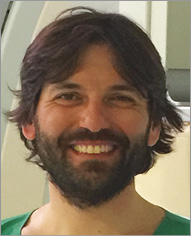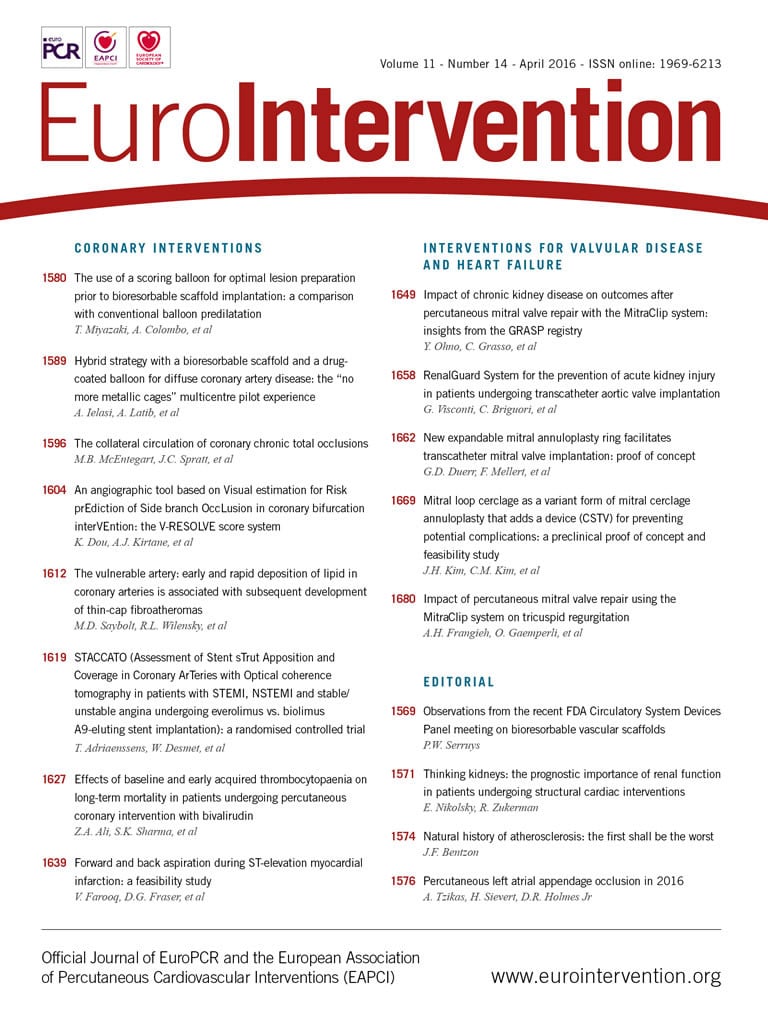NEWS
■ Fellows course: 9-11 June 2016 at the Heart House, Sophia Antipolis, France. This course is designed to aid the continued development of medical doctors who have started or have recently completed a programme of training in interventional cardiology in the core subjects of the syllabus. Register today!
■ Attend the EAPCI General Assembly on Tuesday 17 May from 17:15 to 18:45, on the occasion of EuroPCR 2016 and hear, amongst other things, the EAPCI Board election results. Access the scientific programme of EuroPCR for further information concerning this session.
■ Young female cardiologists and pregnancy: The EAPCI Women Committee is developing a survey on “Radiation protection” the purpose of which is to discover the gender ratio in catheterisation laboratories, to assess real radiation exposure, protection, means of measurement and the educational programme proposed and/or required, as well as the level of awareness about radiation protection. Visit the EAPCI Women web pages to provide your feedback.
EAPCI Focus on the EAPCI Fellowship Experience
An interview with Luigi Biasco, EAPCI Fellowship awardee 2014
Why did you choose this fellowship topic?
Since the beginning of my interventional career I have been interested in the topic of structural cardiac interventions, which nowadays, far from being a simple promise, are showing all their potential in the treatment of our patients. Then, when planning a fellowship comprising both percutaneous coronary interventions and structural interventions, I met my future supervisor, Prof. L. Søndergaard, head of structural interventions in Copenhagen, who has huge experience and worldwide recognition in the field of structural diseases. At that point in time, the convergence between my willingness and the institute’s research interests favoured the choice of the topic of anaemia as a potential prognostic marker in TAVI patients.
Did the fellowship fulfil your objectives?
My fellowship at Rigshospitalet not only fulfilled my objectives, but went far beyond my expectations. During that period, I definitely had the time of my life not only from a professional standpoint but also from a personal point of view. The institute’s ability, progressively and safely, to train young interventionalist fellows to a high level of self-confidence in a relatively short period of time, while exposing them to an incredibly large number of different procedures, technologies, and developing devices, left me absolutely astonished. Besides this, from the very beginning, each and every colleague, from senior consultants to nurses, made me feel an important part of the team, something that is absolutely essential when starting a new experience.
What difficulties did you face during the fellowship?
There are several difficulties to be faced when moving abroad for a fellowship. They relate to both professional and personal aspects, sometimes significantly impacting on the quality of one’s own life. Even if English was commonly used, I still experienced some language difficulties during the initial period of my training, but after a few months my language skills improved consistently. Moreover, housing and bureaucracy are at times energy-consuming processes, often not so easily solvable, especially in large cities. Finally, a large personal predisposition to sacrifice in terms of economic possibilities and distance from loved ones. Nonetheless, taking everything together, the benefits of the period significantly outweighed the difficulties.
Do you have any advice for future applicants?
All my colleagues who wish to obtain and successfully complete a training fellowship should follow some simple rules:
– Be prepared: do your best while working at your home institution. Almost every hospital will allow you to learn basic interventional and scientific skills while you are planning to leave for an international fellowship. Once you arrive at the host institution you will have a faster learning curve both in the cathlab and as a researcher. A good list of published papers will provide a useful introduction for you!
– Plan in advance: fellowships are (unfortunately) a rare event! If you are really interested, try to plan in advance (at least 12 months before leaving). Both your home and your host institution will need a considerable amount of time to plan for your leave of absence/stay and to arrange the necessary paperwork.
– The future is never far away! Before leaving your home institution, try to have a preliminary agreement with your home or future institution for a position as an interventionalist upon your return.
– Go for the best: the interventional training will be the pivot of your future career. Try to obtain your position as a fellow in a very high-volume centre with a known predisposition to training. Procedural volumes will be fundamental to speed up your formation.
– Be humble: when you arrive at the hosting centre as a fellow, spend the first months gaining the trust of your supervisors, of the cathlab personnel, and finally build up your self-confidence and skills. Never do what you’re not expected to do but progressively push forward your limits always bearing in mind your patients’, and your own, safety first.
– Do not watch the clock: when you start your fellowship do not even consider working standard hours! If you are allowed to, try to be a constant presence in the cathlab, even at weekends or during nightshifts… Those are the times when complex cases occur!
– Teamwork: you will find some other fellows or residents sharing their training with you. Try to work as a team both in the cathlab and with your research. Winning as a team is definitely easier than trying to make a solo career.
What are your future career plans?
During my fellowship, I had the opportunity to start an international network with several colleagues working in different European and US hospitals. Soon after the conclusion of my training I received a proposal from Dr G. Pedrazzini, head of cardiology at the Cardiocentro Ticino, the largest cardiac hub in the south of the Swiss Alps. Dr Pedrazzini was one of the colleagues I met during my stay at Rigshospitalet. This allowed me to move to Lugano and to start as a young interventionalist in a place with a complete coronary/structural programme. Moreover, I would like to continue to cooperate with my hosting institution (Rigshospitalet), because of the personal and scientific relationships which began during my period there. Considering the fundamental impact which the fellowship training in Copenhagen had on my professional, scientific and personal formation, I want to strive to work in the future in a milieu that will allow me to share with younger colleagues what I have been taught in terms of technical and research skills.
What was the impact of the support of EAPCI on your fellowship?
Besides economic considerations, which are of fundamental importance when evaluating the sustainability of a fellowship, the EAPCI support certainly represented the best way to be introduced into such a prestigious and world-renowned institution as the Heart Centre at Rigshospitalet in Copenhagen. On the other hand, I also felt the responsibility of showing my mentors and myself that the EAPCI’s investment in me was effectively helping my skills to blossom.
To what extent do you believe that this EAPCI initiative will impact on your career?
The appointment as the young Swiss interventionalists’ national representative to the EAPCI for fellows/trainees is an honour and a testament to the level of training received in Copenhagen and perhaps a small way to repay the EAPCI. This way I hope to help my colleague reach their goal of a proper interventional education and to further the influence of the EAPCI and its role in helping training programmes in Europe. The EAPCI’s aim to reduce the burden of cardiovascular disease in Europe through percutaneous cardiovascular interventions is a multifaceted programme: one of these aspects is the adequate and continuous training of fellows which can help to achieve its target. So far, only a few international centres are clearly devoting their efforts to creating a generation of interventional cardiologists able to deliver a top quality standard of care. What I see as a next step is to encourage many more centres in Europe to dedicate themselves not only to research but also to the training of fellows in intensive, structured programmes such that those skills can be put to work in many other centres when the fellows continue their professional life at other institutions – like ripples on the water. Therefore, I would be honoured to continue sharing my efforts with the EAPCI community to reach this target.

Luigi Biasco, [email protected]
Current institute: Fondazione Cardiocentro Ticino, Lugano, Switzerland
Fellowship institute: The Heart Centre, Rigshospitalet, University of Copenhagen, Copenhagen, Denmark
Fellowship topic: Anaemia in TAVI patients, a possible indicator of poor prognosis?
Fellowship period: 28/11/2013- 01/03/2015
Fellowship lead supervisor: Lars Søndergaard (Structural/Congenital interventions)
Fellowship co-supervisors: Thomas Engstrøm, Erik Jørgensen, Göran Olivecrona (Percutaneous coronary interventions)
Fellowship sponsor: Edwards Lifesciences

